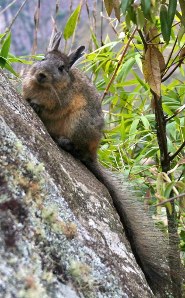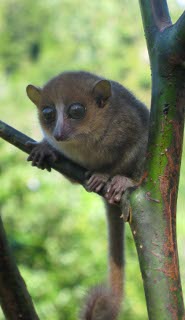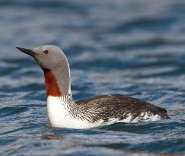Tuesday 31 January 2012
Northern Viscacha - A Sun-Loving Andes Rodent

The Northern viscacha (
Lagidium peruanum), which is also sometimes called the Northern mountain viscacha, is a rodent and a member of the chinchillidae family, which also includes chinchillas. These little guys can be found in
Peru, northern
Chile and possibly
Bolivia and
Ecuador. Although they are typically found between the timber and the snow lines in the Andes Mountains at elevations between 3,000 to 5,000 meters -- or 10,000 feet to 16,000 feet -- they can also be found in low coastal ranges at only 300 meters -- or 980 feet. In addition, the northern viscacha is one of only 70 mammal species that live in the unique Winter Rainfall-Valdivian Forests in Chile.
Northern viscachas make their burrows in the crevices of the rocky habitat they prefer and live in large colonies that can include up to 80 animals. The northern viscacha is not a territorial animal, but colonies tend to be separated from one another by some distance.
Northern viscachas look a little like a cross between a squirrel and a rabbit. They have large ears for their bodies, soft, thick fur, and a bushy curled tail. Northern viscachas that live at lower elevations are typically gray in color, while those living up higher tend to be brown. The fur on their lower body is lighter than their upper parts and can be white, pale gray or yellow. The ends of their long tails are darker than the rest of the northern viscacha's body, usually rust or black in color.
These rodents weigh about 1.25 kilograms on average, or 2.75 pounds, and are approximately 300 to 450 millimeters in length, or about 12 to 17 inches, excluding their tails. This animal's long tail is usually about 200 to 400 millimeters in length, or about 8 to 16 inches.
The rocky territory that the northern viscacha lives in has sparse vegetation, so the little herbivore feeds on the hardy grasses that can survive in this somewhat harsh environment. It also dines on lichens and mosses. Northern viscachas typically feed in the evenings and early nighttime hours. Their daytime hours are usually spent basking in the sun on rocks.
The northern viscacha is a mainstay of the
Andean cat's diet. It is also hunted by
humans for food.
The northern viscacha is currently listed on the IUCN Red List as a species of least concern. It is believed to be a widely distributed species with a healthy population.
Picture of the northern viscacha by Alex Lee, licensed under the
Creative Commons Attribution 2.0 Generic license.
You can help spreading the word about this animal by liking it on facebook
Permanent Link
Wednesday 25 January 2012
Gerp’s Mouse Lemur - Primate Discovered in 2012

The Gerp’s mouse lemur (
Microcebus gerbi) is a tiny, rare primate that lives only in the forests of the eastern part of the island of
Madagascar. Because this species is so new to scientists and biologists, not much is known about them, except that they are nocturnal and they prefer to keep in the lowland section of the forests. Just why they prefer these areas is still unknown.
It is unknown how many are alive, what they eat or what predators eat them (besides humans). Their forests are being cut down for timber and agriculture. The particular area where this new lemur was discovered is not under national protection. We may never learn much about the Gerp’s mouse lemur if its habitat is destroyed.
The Discovery
This long-hidden species was discovered by a group of German researchers in 2012. The name “Gerp” is an acronym for the research organization’s station base, Groupe D’Etude et de Rechurche sur les Primates de Madagascar. The group first arrived in Madagascar in 2008 and first thought the creature now known as the Gerp’s mouse lemur was just a variation of another mouse lemur species.
Several lemurs captured in the Sahafina Forest, skin samples taken and released back into the forest. Its skin samples, along with samples of other lemurs in the area, went to a European lab to have the DNA sequenced. It took years to decode the DNA, but when the results were in, the team knew that they had discovered a new lemur species.
General Description
The adult Gerp’s mouse lemur is only as large as a pet hamster. Adults weigh a mere 2 to 2.5 ounces (60 to 70 grams). But it’s not the smallest mouse lemur in Madagascar. That honor goes to the mountain-dwelling Goodman’s mouse lemur, which weighs a mere 1.55 ounces (44 grams.) Like other lemurs, it has huge eyes in proportion to its head; a pointed pink nose and bat-shaped, mobile ears. The huge eyes and prominent ears help the tiny mammal maneuver in the dark.
The tail, at a whopping 5.77 inches (146.5 millimeters.) is longer than its body and hand-like paws containing six claw-like fingers. The Gerp’s mouse lemur is colored like a Syrian or golden hamster with a sandy brown body and white under parts. The fur is thick, short and dense, with longer hairs on the tail tip, which the lemur holds at rest in a hook shape.
Picture of the gerp's mouse lemur by Blanchard Randrianambinina, licensed under the
Creative Commons Attribution-Share Alike 3.0 Unported license.
You can help spreading the word about this animal by liking it on facebook
Permanent Link
Monday 16 January 2012
Red-Throated Diver - Smallest Diver Bird in the UK

The red-throated diver (
Gavia stellata) is also called the red-throated loon. The red-throated diver spends the summer in countries in the Arctic Circle, including Canada, Scotland, Northern Ireland and Russia. It spends the winters on the ocean waters in warmer climates like California, Japan and Morocco. It is the smallest ocean-diving bird that visits the UK.
They love each other’s company and live in large flocks containing 200 to 1200 birds. When in large numbers, they get some protection from their predators – large sea gulls and
Arctic foxes. If red-throated divers cannot flock on ocean shorelines, they will flock on lakes or even large pools in tundra areas. This species is not endangered, although many die in fishing nets or oil spills.
General Description
The red-throated diver (
Gavia stellata) does, indeed, have a red throat in its adult summer plumage. The rest of this water bird’s body consists of a white belly, dove-grey head, a black tail and a back of brown spots against a grey background. This plumage changes to far less spectacular winter plumage of white and grey, with the red throat changed to white. Chicks sport a fuzzy dark brown down before their first molt.
Males are slightly larger than females. Females weigh only 2.18 pounds (988 grams) while males tip the scales at 5.42 pounds (2460 grams). Females have a wingspan of 41.73 inches (106 centimeters) while male wingspans can reach 45.67 inches (116 centimeters). Both males and females have long wings in relation to their body lengths – 20.86 inches (53 centimeters) for females and 27.16 inches (69 centimeters) for males. These long wings help the red-throated diver to begin flying directly from standing still.
Life Cycle and Habits
Males and females form a pair bond when they are 2 to 3 years old and keep the same sexual partner for life. The female lays one or three eggs per year. Although courtship begins on the water, the nests must be on dry ground. The male selects the nest site. Arctic foxes are adept at hunting these eggs. Males and females take turns sitting on the eggs. After 27 days, they hatch. Chicks follow their parents into the water as soon as their down dries. Seven weeks later, they molt and can fly.
Red-throated divers eat a wide variety of fish, mollusks, fish fry, fish eggs, small frogs, tadpoles, insects, snails, prawns and, rarely, aquatic plants. In order to pursue its prey, the bird can dive down to 29.52 feet (9 meters) and snatch the prey with its long bill.
Picture of the red-throated diver by Ómar Runólfsson, licensed under the
Creative Commons Attribution 2.0 Generic license.
You can help spreading the word about this animal by liking it on facebook
Permanent Link
 The Northern viscacha (Lagidium peruanum), which is also sometimes called the Northern mountain viscacha, is a rodent and a member of the chinchillidae family, which also includes chinchillas. These little guys can be found in Peru, northern Chile and possibly Bolivia and Ecuador. Although they are typically found between the timber and the snow lines in the Andes Mountains at elevations between 3,000 to 5,000 meters -- or 10,000 feet to 16,000 feet -- they can also be found in low coastal ranges at only 300 meters -- or 980 feet. In addition, the northern viscacha is one of only 70 mammal species that live in the unique Winter Rainfall-Valdivian Forests in Chile.
The Northern viscacha (Lagidium peruanum), which is also sometimes called the Northern mountain viscacha, is a rodent and a member of the chinchillidae family, which also includes chinchillas. These little guys can be found in Peru, northern Chile and possibly Bolivia and Ecuador. Although they are typically found between the timber and the snow lines in the Andes Mountains at elevations between 3,000 to 5,000 meters -- or 10,000 feet to 16,000 feet -- they can also be found in low coastal ranges at only 300 meters -- or 980 feet. In addition, the northern viscacha is one of only 70 mammal species that live in the unique Winter Rainfall-Valdivian Forests in Chile.
 The Gerp’s mouse lemur (Microcebus gerbi) is a tiny, rare primate that lives only in the forests of the eastern part of the island of
The Gerp’s mouse lemur (Microcebus gerbi) is a tiny, rare primate that lives only in the forests of the eastern part of the island of  The red-throated diver (Gavia stellata) is also called the red-throated loon. The red-throated diver spends the summer in countries in the Arctic Circle, including Canada, Scotland, Northern Ireland and Russia. It spends the winters on the ocean waters in warmer climates like California, Japan and Morocco. It is the smallest ocean-diving bird that visits the UK.
The red-throated diver (Gavia stellata) is also called the red-throated loon. The red-throated diver spends the summer in countries in the Arctic Circle, including Canada, Scotland, Northern Ireland and Russia. It spends the winters on the ocean waters in warmer climates like California, Japan and Morocco. It is the smallest ocean-diving bird that visits the UK.